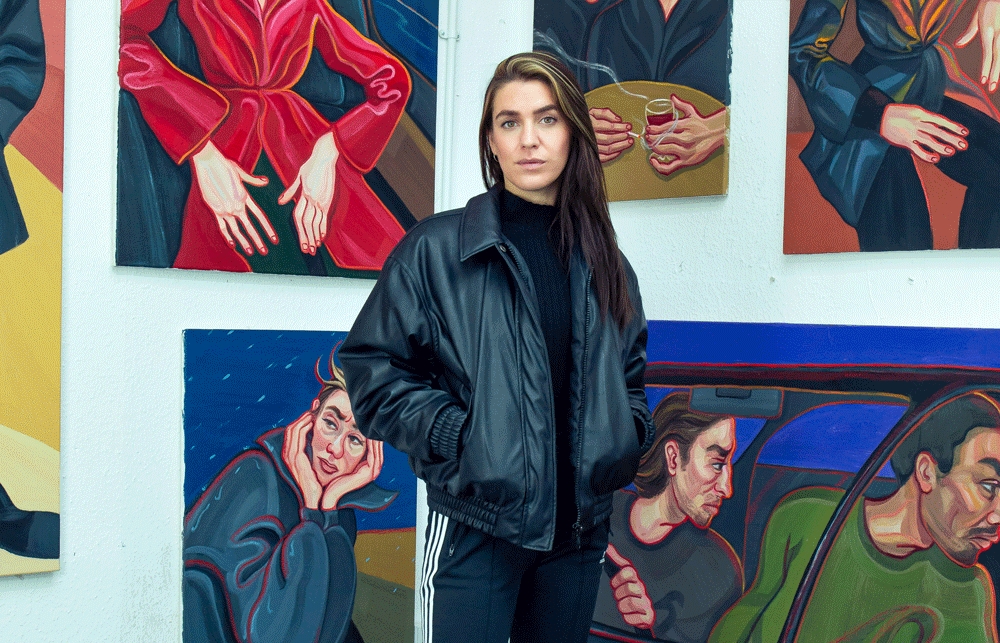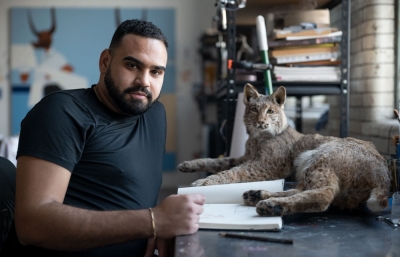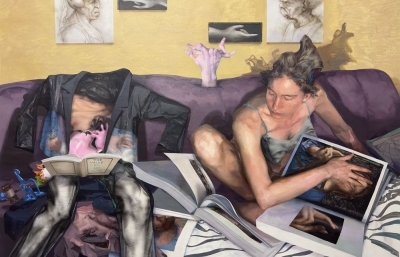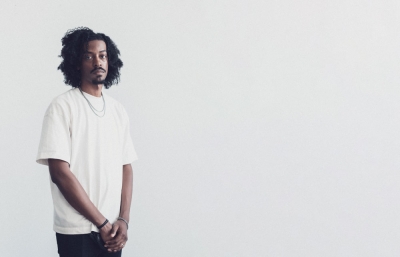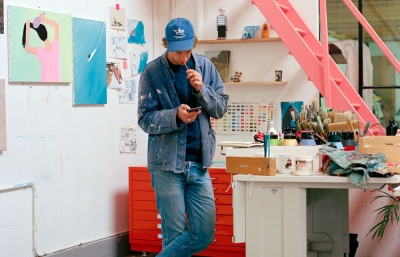Ania Hobson
Cool, Calm Composer
Interview by Gwynned Vitello // Portrait by Jahed Quddus
Picture a dog lolling around on his back, legs akimbo, or a cat awakening from its nap, stretching and ready to stalk. A tree in the winter, shedding leaves but not its dignity. Ania Hobson grew up in the country, painting the surrounding movement and natural color, and with that keen eye for posture and perspective, she now paints portraits of people comfortable and confident, whether lost in thought or deep in conversation. There’s beauty in loose strands of hair and the shadows of a face. It’s life and that’s good.
Gwynned Vitello: I figure most British artists work out of London, and maybe Bristol, Bath or Liverpool, but how many have studios in Ipswich in Suffolk County? My dad’s family were from the town, so I’m curious to know more about it and why you’ve chosen to stay in what’s been called the “curious county.”
Ania Hobson: I moved to Suffolk when I was five, but I spent my first years in Wyre Forest, Worcestershire where I was born. Our house was surrounded by deep, thick forest which became our playground, and here we explored and played for hours. Those childhood experiences have become deeply embedded in my psyche. This focus on animals and nature continued when we moved to Suffolk—and that connection has never left me. Suffolk is my base, with affordable studio rent, but it’s also so close to London. An hour on the train takes you straight into Liverpool Street. As much as I love Suffolk, though, I am slowly considering moving to a bigger city where connecting with other artists and exhibitions is more accessible.

The rural setting of childhood must have really informed your first expressions of art. Tell me about those first impulses. Did animals and trees just naturally present themselves as subjects? Did your parents encourage you, and did you have the luxury of alone time?
I think both my parents being zoologists was the starting point for me, and also that we were privileged to live in a rural village. They taught us from an early age about nature and wildlife, which made me take an interest. I remember sitting in our barn where my mother kept a few goats. I would spend hours sitting next to them in the straw, with their newborns curled up next to them, with the natural light dropping down through the barn windows. There was something so calming about that. Even though I was one of three siblings, we were taught how to spend time alone watching nature, which I feel has developed into me being an observer. Drawing animals from life at the beginning was a great practice which taught me to be quick with my mark making, which is something that I still use today.
Although you started sketching animals, portrait painting is considered your artistic identification. Painting people is richer with potential, but tell me about the similarities in your portrayals of man and beast (as I ask, I’m covered in dog hair at the moment).
The transition from animals to humans came slowly but naturally. Growing up on a small holding, I had learnt to be sensitive to the animals’ needs, health and moods. So I learnt what was going on. Then I started drawing figures at primary school, at the stage when we become self aware and aware of the people around us. As I got older, I became fascinated by other people and how they react to each other. Humans are alway trying to read and analyse others’ body language and unspoken ways of communication. This, for me, was magnified because I had difficulties with my hearing until the age of 4. I was constantly reading faces and reactions. I used to draw out all of these characters in my lessons and then turn them into comic strips as requests for my classmates. I feel like I have subconsciously reverted to this in my current work.
In what way did going to art school erase any early habits and what natural proclivities did it strengthen?
My university experience was not entirely positive. I felt that the vision that my tutors believed in didn’t fit where I was coming from at all. I came within two months of failing my degree and was being told that portraits wouldn’t get me anywhere, although painting faces was my passion. I felt like it truly represented me and I wanted to portray this in my art. I didn’t want to change my work for the “right route” into the art world, but to be honest and truthful to who I am and how I see the world through my eyes. Feeling misunderstood did make me even more determined than ever to continue with figurative painting, which I guess turns out to be a positive outcome of my degree experience.

How long before you went to the Florence Academy of Art? What was the most important aspect of that training, and what was a fond, enjoyable memory from the experience?
In 2014, I went to Florence for the first time to try to build my knowledge and skills in portrait painting. It was an amazing experience, arriving in one of the most beautiful cities in the world with my suitcase packed with paints and brushes surrounded by Renaissance art, Botticellis… and even outside of museums, it was one of the most intoxicating experiences. I learned so much about the process of technically painting portraits, like mixing skin tones and just really using my eyes. It felt like I was living and breathing a world of art every day. My painting isn’t traditional, but going back to these techniques grounded my work and taught me so much. After a long day of standing and painting, with half an hour to spare, we would often run through the loud, crowded streets of Florence from the studios to the Uffizi Gallery to make it just in time to see a Botticelli and a quick view of the sunset over the Pote Vecchio as the gallery was closing.
Was there a growth in confidence, and how did you perceive your move from student to professional?
My experience studying in Florence had a fairly profound effect on my development as a painter. I continued to submit new paintings into various competitions, like The Threadneedle, Royal Society of Portrait Painters and the BP Portrait Awards, which gave me the confidence to continue painting and forge a career. The competitions acted as a springboard into gaining exposure and experience, and probably also to working towards a tight deadline—something every artist finds challenging!
Can you describe how a painter, or you as a painter, comes to realize the type of medium you want to choose, say oil or acrylic, even the color palette, and how they help you materialize your vision? How has that changed for you?
I started off using acrylics in college, which I personally found chalky and limiting. Then, at University, I started using oils, but without the right guidance, so I found I had to teach myself pretty much, until Florence. Oils have a way of holding texture together, and especially with impasto, I find that mark making and brushstrokes are so much more rewarding. I become very focused on the application of paint and how it moves, so sometimes, the subject becomes secondary for me.

Is it true that you prefer painting a live subject rather than a photograph? What’s the difference in how you approach them?
I have used all techniques, and I still do draw from life. But, in the earlier stages, I felt like this was a rule to painting, and that using photographs was frowned upon. I did rely on photographs for a few years because I generally prefer to work privately without the pressure of someone else in my studio. For the last year, I’ve put that aside and started working directly from my sketchbook, drawing them straight onto canvas. I prefer the freedom of my own hand rather than constricting myself to trying to replicate an anatomically correct vision of the human form. Drawing is a way of freeing myself up and being able to exaggerate the features I want to focus on. I want you to look at my figures as if you are dreaming of someone you know, not quite themselves, but more like a collage of what you know of them.
I’d like to know more about the actual portrait process, even from the sitter’s point of view. Once you have kind of set-designed your subjects, do you chit chat, listen to music, ever come to a realization that it’s not going in a direction as planned?
Nowadays, I only have sitters for private commissions where I draw and photograph them for future reference once they leave the studio. I start with graphite straight onto the canvas whilst talking to my sitter. The downside is that there is a pressure for getting a likeness of them, and they feel equally like this experience, for them, is part of the exchange they're owed of me commissioning a portrait for them. When I’m painting non-commissioned paintings, I often use my sister as a model and have her wear certain clothes or even act out scenes with me. I use myself a lot as well. I collect coats and other items from charity shops, sometimes purely for painting.
Do you work on one painting at time, or do you have several in various stages? What governs that approach?
I don’t generally have multiple paintings going—once I have an idea, I like to get it out as soon as possible because I don’t want to lose the feeling of freshness. I can get bored of an idea very quickly, and my style of painting is very fast with minimal detail. A lot of the work is mark making. I don’t paint much detail as I want to feel that my paintings are getting tight or that emphasis on planes of color and angles gets lost.

Winning the National Portrait Gallery’s BP Young Artist Award for A Portrait of Two Female Painters had to have been a huge thrill. How did that particular piece come about? Did you paint it with the competition in mind, or was it in your collection just waiting for the right moment?
Without a doubt, that was such a great experience, though I had left it far too late to submit and had only two weeks to come up with an idea. The painting depicts me and my sister-in-law, Stevie Dix, who is also a painter and was, at the time, working in the same studios at RAF Bentwaters, a disused US Air Base in Suffolk. I felt in that moment that I wanted this painting to be natural and show how we are actually seen in our studios, no glamour and no frills. I was thinking a lot at the time about feminism and post-feminism and the role of women in all industries, specifically for this work, the creative industry. Once submitted, a painting goes through three processes, the last being short-listed for an award. I got a phone call, out of the blue, informing me that I had won one of the awards, but wouldn’t know which one till the actual ceremony. The night was a blur of excitement, drinks, press and nerves with a final dinner with all the winners and dignitaries sitting in one of the glorious halls of National Portrait Gallery—with the Old Masters looking on.
Women painters are portraying their female subjects as more emancipated subjects, enjoying each others’ company and often (finally) free to indulge themselves. What I like about your renderings is that they are so egalitarian, women who accept each other as equals, who take on the world without pretense, presented matter of factly. Is that a fair interpretation?
Yes, absolutely, that is a correct interpretation. I want to portray my women as who we are in reality, without the glamour veneer that the world has always insisted on painting us with. We are not strictly the damsels in distress or the glamour models that the world wants us to be, playing on the madonna-whore dichotomy. I paint women in big, blocky coats and angry, chunky boots, responsible for our own lives and decisions. The fashion that I portray my female subjects is almost military and assertive, and definitely grounded—a tribe making their mark in the world. Equally, clothes should not define us, and that might be part of the reason why I dress my models in androgynous clothes. It’s also a reflection of myself and what I wear.
In fact, by illustrating them so authentically, you leave room for a story beyond the portrait. What do you have in mind when you prepare, like, what’s the chicken and the egg?
In many paintings, I’m asking the observers to finish the story themselves, and everyone will have a different viewpoint and interpretation. This is my way of getting the viewer to engage with the painting and equally with themselves. A character that is portrayed looking into an ambiguous background or distance undoubtedly has a story to tell—and I like to invite the viewer to enter that internal narrative.
I imagine you’re influenced by Lucien Freud and maybe David Hockney. If so, tell me how—and if not, who are some influences?
Lucien Freud was probably my first massive influence. I specifically remember visiting his exhibition at the National Portrait Gallery and being completely sucked in by his brush strokes close up. Paula Rego’s narrative and contorted figures, as well as the freedom of Alice Neel’s portraits are influences. Kerry James Marshall is another, especially his edgy subject matter and blocky, flat planes of color.

When did you start doing self-portraits and how do you approach painting yourself?
I’ve been painting self-portraits since I can remember. Initially, they were always a faithful interpretation of my own features. Increasingly, I have begun to use myself as just a general human-face model, as a way of letting go of something that has been troubling me. My face can appear very recognizable, and other times you wouldn’t know it was me. I use myself as reference if I’m struggling with creating the shape of a face or getting the light and dark tones right. So, even when not deliberately making a self-portrait, I’m often my own model!
Thomas Gainsborough dressed his Blue Boy in royal satin, and while you’re not Cindy Sherman, you do accessorize your subjects. How do you make the fashion choices?
I dress my models according to the palette choice of the painting, as well as try to use clothes that have cuts and fabrics that will naturally create shapes. They are also a big part of creating the composition and maintaining cohesion throughout the work. The clothes carry the faces, which are central to my painting; ultimately, I want to portray a story that is interesting and pleasing to the eye
Asylum Studios sounds like a great place filled with musicians and other artists, but for your work, I kind of see you working alone.
My studio within Asylum is at the old American Air Base in Suffolk, and my space is the old, converted interrogation room where, 40 years ago, the American soldiers who witnessed the famous Rendlesham UFO incident were questioned about their sightings of strange lights and a craft they supposedly saw that landed in the forest nearby. A wall holding a two-way mirror has now been removed, so my space is quite big. The mirror, a relic of that story, occasionally makes an outing into the gallery as part of someone’s concept for an exhibition. In a funny way, this old interrogation room again serves a purpose to “read people,” in as much as I use it to paint people’s stories and invite others to interpret what they see. I do like to work alone, with my ears plugged into podcasts or music. But it’s great to work in a place where there’s plenty of company if you want it. We’re a really diverse group, and the shared space is a great sounding board for ideas and expression.
How has the pandemic affected your work?
Working through Covid-19 has been a strange and stressful experience. Initially, it meant that my show with Catto Gallery was delayed by five months, which did help me to get my final body of work together, even though I couldn’t access my studio for weeks. When I eventually did get back in, the isolation sort of helped me to focus and think about my vision for the show. I tried to paint at my house, which I really struggled with, because home is usually a place for relaxing, and it was unusual bringing my work into that space, along with the uncertainty.
Do you have new paintings planned, gallery shows or a dream destination in the more distant future?
I have two exhibitions coming up for 2021, a solo with the Gillian Jason Gallery, a group show with Thompson’s Gallery in London in March, and am also showing some paintings with the London Art Fair. My dream destination would be to have a solo show in the US!

